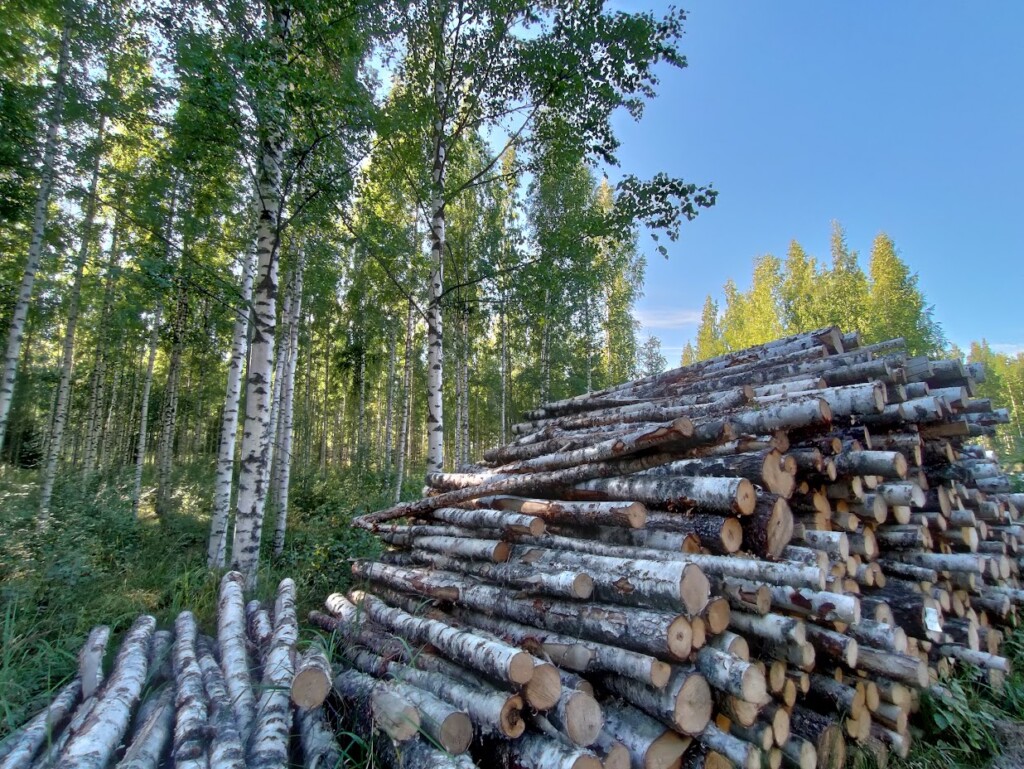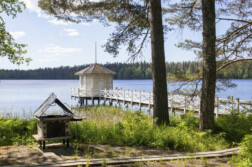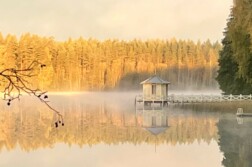Authors: Aaron Vänskä, Anuoluwapo Moses, Darja Martsenkova, Niko Hokkanen, Xun Lei
As the first international forestry students in Evo, we embarked on our studies in forestry policy and economy at the beginning of 2024. Upon discovering the debate surrounding Evo’s potential designation as a national park back in 2020, we immediately recognized this as an ideal real-life case to study forestry policy. As we delve deeper into the case, we realize there is much more for us to learn, as well as for our readers.

The Evo Science National Park was initially proposed by a group of scientists at the Lammi Biological Station. The idea was to promote science to the public and preserve natural habitats. The initial proposal, lacking input from bordering landowners and other stakeholders potentially affected by the implementation of a National Park, became the primary obstacle to the project’s progress. The proposal garnered immediate negative feedback and polarization. Consequently, disagreements have sparked between the different interest groups and the National Park proposal has come to a halt.
What Evo Offers Currently

Currently, most of the land in the Evo area is owned by Metsähallitus and is designated for commercial forestry, conservation purposes, educational forestry, and recreational facilities. The remaining portion is privately owned by individual landowners. At the heart of the Evo area lies the demonstration forest of the HAMK Evo campus, which serves as a focal point for forestry activities.
The multifaceted landscape of Evo highlights its importance as both a recreational and educational resource. Evo presents opportunities for everyone; from hunters to researchers to campers. Evo area is one of the largest areas in southern Finland where hunters without owning large area of lands can obtain license hunt. Featuring hiking and biking paths, skiing tracks, fireplaces, and camping shelters, the area accommodates a wide range of interests and activities, rendering it a valuable asset for both local residents and visitors. Consequently, a proposal for a national park can be viewed as a step forward from the current state. However, some would say that the existing facilities meet expectations adequately, and thus, investing in further development may not be necessary.
The Need for Conservation

In the proposal, one of the main arguments is conservation needs. Southern Finland’s forests face significant challenges, primarily stemming from fragmentation and a lack of protected areas. In Southern Finland, only approximately 4% of the total land area consists of protected forests, with a noticeable absence of pristine old-growth forests. Currently, the focus of all national parks is predominantly in Northern Finland, where the majority of state-owned forests are situated. This situation in Southern Finland fails to sustain biodiversity effectively, leading to a practical decline in biodiversity.

Furthermore, in alignment with the European Union’s biodiversity strategy, a target has been set to protect 30% of the EU’s forests by 2030, with 10% under strict conservation measures. Finland has committed to these objectives, and this initiative would contribute significantly to achieving this target. Evo already possesses some areas of protected forest, laying a solid foundation for a potential national park project. By designating nearly 5000 hectares for conservation, threats to endangered species can be mitigated, and the region’s distinct biodiversity can be preserved for future generations.
Alongside the EU’s conservation goals are also the United Nations’ goals for sustainable development. These goals include a wide variety of objectives with the ultimate goal of peace and prosperity for people and the planet. One of the goals specifically mentions the protection of biodiversity and natural habitats and as a UN member state, this target would be much more feasible for Finland to accomplish with the dedication of a large protected area in southern Finland.
The Scope of Scientific Research Could Be Expanded
The establishment of the National Park would not only protect endangered species but also provide valuable opportunities for scientific research. Studying the behavior and success of plant and animal species within the park can offer insights into effective conservation strategies. Additionally, the park’s designation as a scientific research site could facilitate collaborations among researchers, leading to a deeper understanding of ecosystem dynamics and informing sustainable land management practices beyond the park boundaries.

A substantial benefit of the National Park in terms of scientific research is that it could allow researchers to do long-term studies on the ecosystems, wildlife, and habitats. With the Evo area still in commercial forest use, the forests are undergoing constant change, and scientific research is bound to experience interruptions and interference.
Another unique aspect of having a large protected area in Evo is its proximity to the HAMK School of Forestry. This presents an opportunity to enhance sustainable forestry practices by comparing the protected forest with industrial forestry operations. The ability to have sustainable forest management practiced beside a protected area could give many insights into the behavior of animals and the growth of plant species both in and out of the park’s boundaries.
However, forestry teaching and research may involve activities such as tree cutting and other silvicultural practices, which could potentially be perceived as forest destruction by visitors to the national park. Therefore, it is imperative that the proposal for the national park includes a comprehensive analysis of its impact on HAMK, especially regarding the activities of forestry students, as highlighted by Evo students in 2020. Will the establishment of the national park lead to criticism of forestry teaching practices that involve tree felling and prescribed burning within the teaching forest? This question necessitates careful deliberation and dialogue within the forestry community.
Conserving and Enhancing Biodiversity
The most important factor for a healthy ecosystem is the growth and preservation of biodiversity. Many commercial forests largely consist of a single tree species within a certain age range. This formula for forest growth is beneficial from the financial perspective but is detrimental to the range of other species trying to grow within that forest. Protected forests do not rely on the possibility of profit, which negates the need for management and therefore offers a haven for any plant and animal species to survive and thrive.

Biodiversity loss is an issue that the whole world is facing and dedicating more areas to protection can slow the rate of increasing endangerment. The Scientific National Park that is proposed for the Evo area could protect many species that are not only endangered but also unique in the climate and conditions of Southern Finland. In a society more attuned to sustainable growth and development, we should make an effort to leave areas untouched for the benefit of the other species we share this land with.
Another intriguing debate surrounding biodiversity concerns the spread of bark beetles, a problem observed in countries like Germany and the Czech Republic. Some landowners are concerned about bark beetles migrating from natural forests to commercial ones. However, scientists and activists argue that biodiversity can mitigate this issue by enabling various species to compete within natural ecosystems.
Traditions of hunting in Evo
While conservation efforts are paramount, the proposal for the National Park has sparked concerns among hunters, who fear the loss of access to traditional hunting grounds. Evo has a rich hunting tradition, with hunters from across Finland coming to the area to pursue game such as moose and deer. Restricting hunting within the park boundaries could have implications for both the hunting community and the ecosystem.

To address these concerns, one proposal has been put forward to permit limited hunting to preserve traditions within the area and manage wildlife populations through alternative methods, such as controlled culling. Another proposed solution was to drive deer and moose out of the national park area onto private land or state-owned land. However, this is not a very effective solution, and the risk of misunderstandings and violations would be present.
Striking a balance between conservation goals and hunting traditions remains a challenge. Additionally, concerns regarding the potential rise in wildlife populations, leading to ecological imbalances and increased rates of traffic accidents, highlight the complexity of the issue. John Loehr PhD of the University of Helsinki noted that traffic accidents on roads passing through dense natural forests are fewer compared to those passing through managed forests.
How the Science National Park Would Affect the Surrounding Areas
The establishment of the National Park could yield significant economic consequences for the region, encompassing both positive and negative aspects. While some landowners express concerns about potential revenue losses from forestry operations and the reluctance of companies to purchase wood from near the national park due to public scrutiny, others perceive opportunities for economic expansion through tourism and job creation.

Job creation emerges as a notable potential advantage of the National Park proposal. By employing park rangers, guides, maintenance staff, and administrative personnel, the park could generate employment opportunities for local communities. Additionally, heightened tourism resulting from the park’s designation could stimulate growth in associated sectors such as hospitality, retail, and transportation.
Nevertheless, it is imperative to assess the long-term sustainability of these economic benefits. Striking a balance between conservation objectives and economic interests will be essential to ensure that the advantages of the National Park are realized without compromising the integrity of the ecosystem.
The Proposal and Following Discussions Lacked Clear Communication

Effective communication was not present during the proposal’s first stages and failed to engage key stakeholders, such as landowners, during the drafting stage. Had proper communication been conducted, some landowners may have been less likely to perceive the proposal as an attempt to affect their property, referencing past experiences with the implementation of the Natura 2000 network. It’s worth noting that current legislation protects the landowners’ rights, and such concerns are unfounded but the lack of accurate information and communication caused unnecessary polarization in the initial stages.
Navigating challenges such as the Covid-19 pandemic and historical mistrust between stakeholders, stemming from past experiences with Natura 2000, must be approached with care. Online meetings proved to be an ineffective communication method due to the absence of personal connection. This only increased the likelihood of misunderstandings between interest groups.
Furthermore, misinformation spread by the media only furthered the conflict. For example, some media outlets definitively claimed that buffer zones would be implemented on private land and landowners on the borders of the National Park would have to leave their forests unmanaged to protect the borders of the conservation area. However, this claim is untrue as the government cannot seize land from landowners for their use but statements like this only increase the division between the landowners and the proponents of the park.

Thoughts…
The proposal to establish a Scientific National Park in the Evo area presents both opportunities and challenges. As international students, delving into this case of political debate broadens our understanding of Finnish forest policy and regulation. It recalls the famous Eastern proverb “Inquiring about the stance, not about right or wrong,” which criticizes those who prioritize their own stance without regard for facts or moral considerations. Such an attitude can strain relationships and be detrimental to the community we all inhabit.
As forestry students, we want to take all considerations into account when discussing a topic such as this one. We sympathize with the idea of conservation as our passion for nature was one of the drivers in choosing this field of study but we can also see the need for commercial forestry as it is one of the main drivers in this country’s economy. Our forestry studies complement, rather than contradict, efforts in nature protection, and by building sustainable forest management methods through conservation research we can protect nature for future generations. Through this case study, we see ourselves as future bridges between the forestry industry and nature conservation.
Despite the delay in the proposal, it sparks a crucial debate about achieving a balance between the requirements of the forest industry and those of nature conservation. Can we devise methods to meet the demands of timber production while giving priority to nature conservation?




